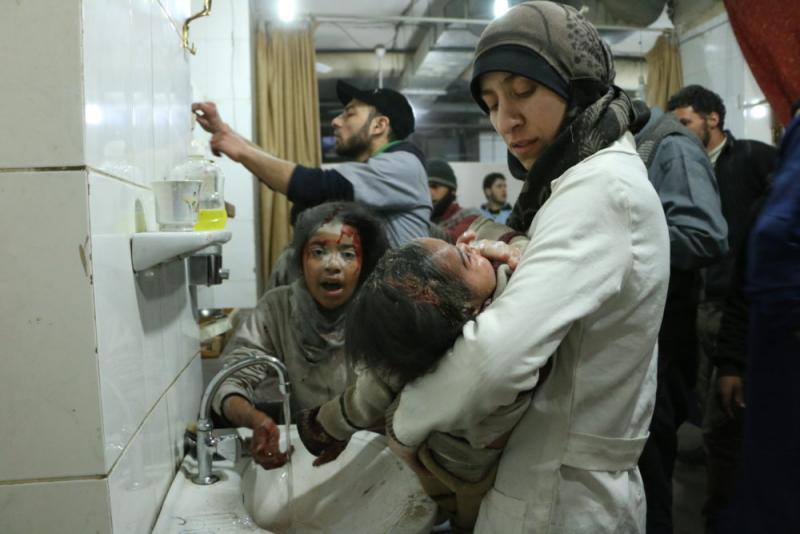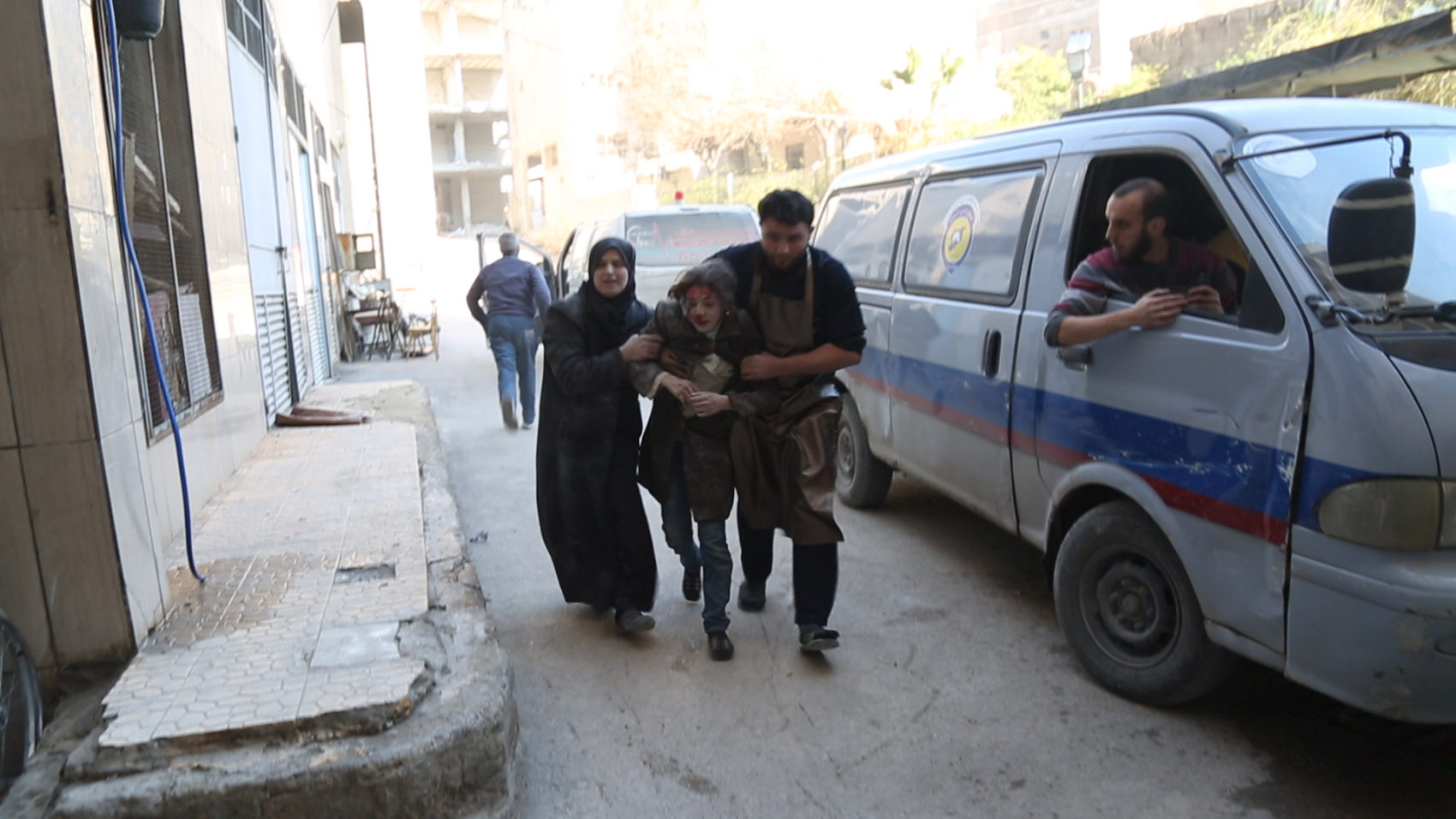The Cave review - heroic Syrian hospital workers | reviews, news & interviews
The Cave review - heroic Syrian hospital workers
The Cave review - heroic Syrian hospital workers
A pediatrician's view of indiscriminate slaughter in Eastern Ghouta

War crimes are war crimes, irrespective of the victims’ ages, gender, or ethnicities, and no one’s torture or murder is more abhorrent than anyone else’s.
This is a way of saying that The Cave, the latest documentary directed by the Syrian filmmaker Feras Fayyad, maker of 2017’s Last Man in Aleppo, is as imperative a watch as it is a gruelling one. It is seen from the perspective of – and partially narrated by – Dr. Amani Ballor, a pediatrician who turned 30 during the course of the filming. Manager of a hospital in a warren dug beneath Eastern Ghouta, the so-called rebel stronghold of 400,000 trapped citizens near Damascus that was besieged by Bashar al-Assad’s regime and its Russian allies between 2013 and 2018, Ballor saved numerous children’s lives.
Time and time again, Fayyad shows kids being rushed into the hospital after a bombing raid and Dr. Amani, as she’s known, making instant diagnoses and treating victims on the spot, coaxing bits of rock and shrapnel from babies and toddlers’ mouths, for example. In one tears-inducing scene, she tends a little girl with henna-stained hands who, seemingly little harmed by a bombing moments before, is evidently in shock; Amani’s tenderness keeps the girl smiling, even as she mentions her father’s recent killing by a car bomb, and plants the seed in her that she, too, could one day become a doctor, or a teacher. As we get to know Amani, so we do three of her equally heroic colleagues in the hospital of 150 staff. There is Samaher, the stoical nurse who, though she suffers memory lapses, cooks, cleans, and keeps everyone’s spirits up with her rowdy humour. Surgeon Dr. Salim, a classical-music lover, plays YouTube concert videos on his propped-up smartphone – the music is in lieu of anaesthesia, he says – while he operates. Alaa is the unflappable young woman doctor, who accompanies Amani on a dangerous excursion beyond the hospital to visit a little girl with blood cancer and a baby boy who can’t sit up owing to malnutrition. Since only the government and the Red Cross can permit the girl and her mother’s evacuation, Amani curses Assad, not for the only time in the film. God, too, gets a rebuke from her, and you can see why.
As we get to know Amani, so we do three of her equally heroic colleagues in the hospital of 150 staff. There is Samaher, the stoical nurse who, though she suffers memory lapses, cooks, cleans, and keeps everyone’s spirits up with her rowdy humour. Surgeon Dr. Salim, a classical-music lover, plays YouTube concert videos on his propped-up smartphone – the music is in lieu of anaesthesia, he says – while he operates. Alaa is the unflappable young woman doctor, who accompanies Amani on a dangerous excursion beyond the hospital to visit a little girl with blood cancer and a baby boy who can’t sit up owing to malnutrition. Since only the government and the Red Cross can permit the girl and her mother’s evacuation, Amani curses Assad, not for the only time in the film. God, too, gets a rebuke from her, and you can see why.
In one especially upsetting sequence, children struggling to breathe are brought into the hospital following the chlorine attack of April 7, 2018, that led to 500 people being admitted to different medical facilities. A mother howls as she realizes her son, glimpsed briefly on a gurney, has died; Salim buries his head in his hands and weeps after this atrocity, as Amani weeps on another occasion and Samaher goes into a near fugue state. However, it would be wrong to say the film is unflinching. Fayyad necessarily avoids showing the worst of what happened, and leaves Amani to state, as she, Salim, and Samaher are evacuated at the end, “No one can imagine the things we’ve seen”, and “I’m afraid that what I saw will haunt me forever”.
The Cave’s disturbing subtext is the ingrained misogyny that Amani has to deal with as a female physician and hospital administrator. Early in the film, an aggrieved young husband calls on the hospital to complain that he can’t get medication for his wife owing to what he believes is the incompetent management of Amani, whom, he says, “should be at home with her children”; Salim rushes to her defence. Amani’s father, speaking to her on a phonecall, complains that people are whispering that she shouldn’t work as a doctor. When Amani offers a hospital job to the mother of the malnourished boy and his two siblings to help her pay for medications, the woman says the men in her family wouldn’t allow it. Blaming men’s exploitation of religion for this oppression, Amani vows to fight it, as if she hasn’t got enough on her plate.
I saw The Cave a few days after seeing Sam Mendes’s single-shot World War I film 1917 and was struck by the similarity between the network of tunnels that comprised the hospital and the Western Front trenches through which Mendes’s camera follows two British infantrymen on a crucial mission. (National Geographic’s financing of The Cave enabled Fayyad to include a digital map of the Eastern Ghoutta labyrinth that rather flashily disappears into a closeup of one of Amani’s eyes.) Worthy though 1917 is (if aesthetically problematic), it struck me as sad that more people will likely see it, as a big entertainment movie, than The Cave – the horrendous real-life events it depicts having occurred while most of us have been living comfortable Western lives. To not see it – and Waad Al-Kateab and Edward Watts’s likeminded For Sama, as well – is to bury one’s head in the sand.
The future of Arts Journalism
You can stop theartsdesk.com closing!
We urgently need financing to survive. Our fundraising drive has thus far raised £49,000 but we need to reach £100,000 or we will be forced to close. Please contribute here: https://gofund.me/c3f6033d
And if you can forward this information to anyone who might assist, we’d be grateful.

Subscribe to theartsdesk.com
Thank you for continuing to read our work on theartsdesk.com. For unlimited access to every article in its entirety, including our archive of more than 15,000 pieces, we're asking for £5 per month or £40 per year. We feel it's a very good deal, and hope you do too.
To take a subscription now simply click here.
And if you're looking for that extra gift for a friend or family member, why not treat them to a theartsdesk.com gift subscription?
more Film
 Die My Love review - good lovin' gone bad
A magnetic Jennifer Lawrence dominates Lynne Ramsay's dark psychological drama
Die My Love review - good lovin' gone bad
A magnetic Jennifer Lawrence dominates Lynne Ramsay's dark psychological drama
 Bugonia review - Yorgos Lanthimos on aliens, bees and conspiracy theories
Emma Stone and Jesse Plemons excel in a marvellously deranged black comedy
Bugonia review - Yorgos Lanthimos on aliens, bees and conspiracy theories
Emma Stone and Jesse Plemons excel in a marvellously deranged black comedy
 theartsdesk Q&A: director Kelly Reichardt on 'The Mastermind' and reliving the 1970s
The independent filmmaker discusses her intimate heist movie
theartsdesk Q&A: director Kelly Reichardt on 'The Mastermind' and reliving the 1970s
The independent filmmaker discusses her intimate heist movie
 Blu-ray: Wendy and Lucy
Down-and-out in rural Oregon: Kelly Reichardt's third feature packs a huge punch
Blu-ray: Wendy and Lucy
Down-and-out in rural Oregon: Kelly Reichardt's third feature packs a huge punch
 The Mastermind review - another slim but nourishing slice of Americana from Kelly Reichardt
Josh O'Connor is perfect casting as a cocky middle-class American adrift in the 1970s
The Mastermind review - another slim but nourishing slice of Americana from Kelly Reichardt
Josh O'Connor is perfect casting as a cocky middle-class American adrift in the 1970s
 Springsteen: Deliver Me From Nowhere review - the story of the Boss who isn't boss of his own head
A brooding trip on the Bruce Springsteen highway of hard knocks
Springsteen: Deliver Me From Nowhere review - the story of the Boss who isn't boss of his own head
A brooding trip on the Bruce Springsteen highway of hard knocks
 The Perfect Neighbor, Netflix review - Florida found-footage documentary is a harrowing watch
Sundance winner chronicles a death that should have been prevented
The Perfect Neighbor, Netflix review - Florida found-footage documentary is a harrowing watch
Sundance winner chronicles a death that should have been prevented
 Blu-ray: Le Quai des Brumes
Love twinkles in the gloom of Marcel Carné’s fogbound French poetic realist classic
Blu-ray: Le Quai des Brumes
Love twinkles in the gloom of Marcel Carné’s fogbound French poetic realist classic
 Frankenstein review - the Prometheus of the charnel house
Guillermo del Toro is fitfully inspired, but often lost in long-held ambitions
Frankenstein review - the Prometheus of the charnel house
Guillermo del Toro is fitfully inspired, but often lost in long-held ambitions
 London Film Festival 2025 - a Korean masterclass in black comedy and a Camus classic effectively realised
New films from Park Chan-wook, Gianfranco Rosi, François Ozon, Ildikó Enyedi and more
London Film Festival 2025 - a Korean masterclass in black comedy and a Camus classic effectively realised
New films from Park Chan-wook, Gianfranco Rosi, François Ozon, Ildikó Enyedi and more
 After the Hunt review - muddled #MeToo provocation
Julia Roberts excels despite misfiring drama
After the Hunt review - muddled #MeToo provocation
Julia Roberts excels despite misfiring drama
 London Film Festival 2025 - Bradley Cooper channels John Bishop, the Boss goes to Nebraska, and a French pandemic
... not to mention Kristen Stewart's directing debut and a punchy prison drama
London Film Festival 2025 - Bradley Cooper channels John Bishop, the Boss goes to Nebraska, and a French pandemic
... not to mention Kristen Stewart's directing debut and a punchy prison drama

Add comment